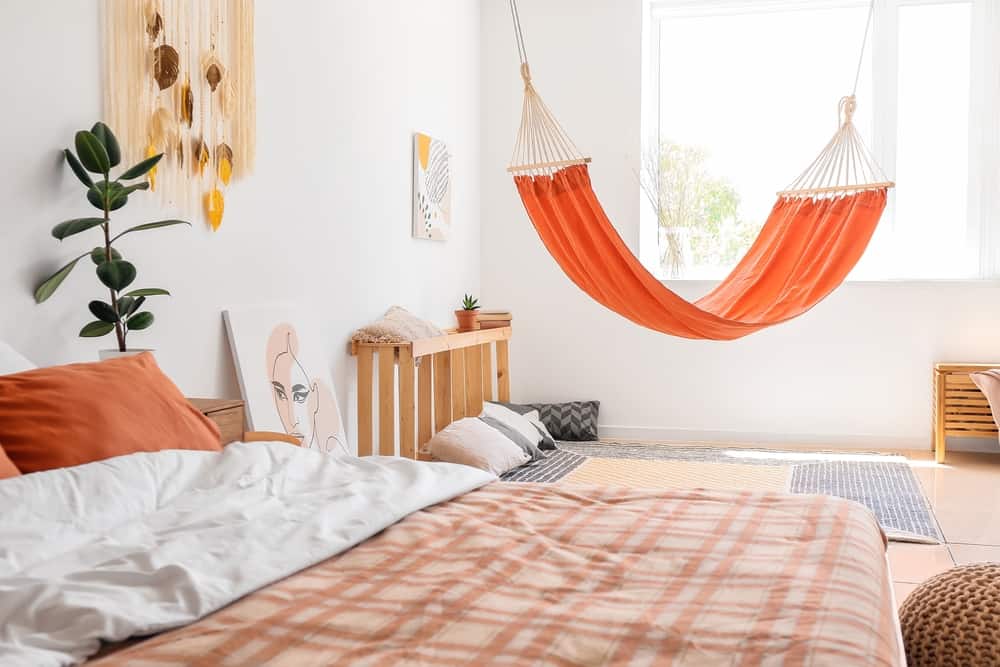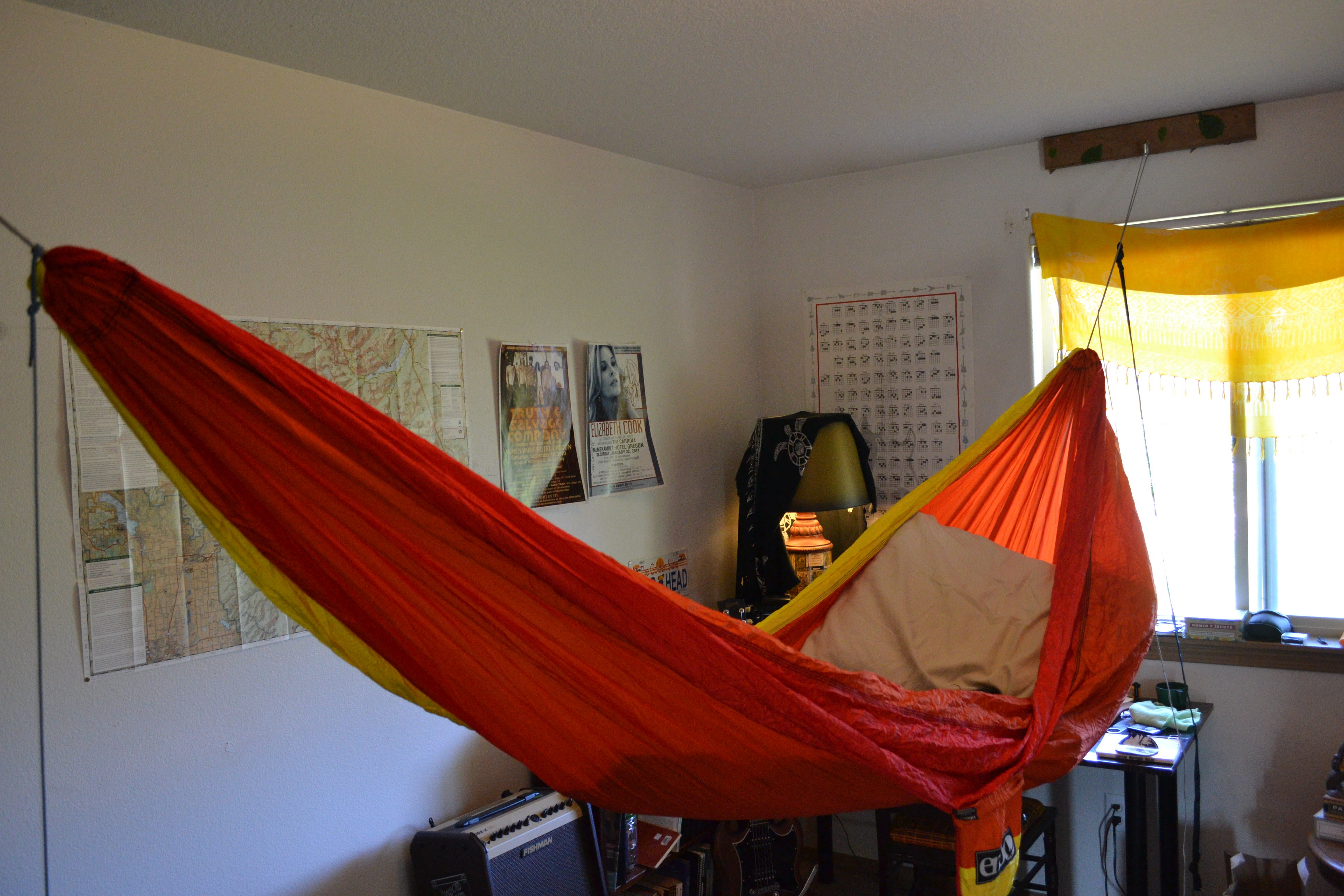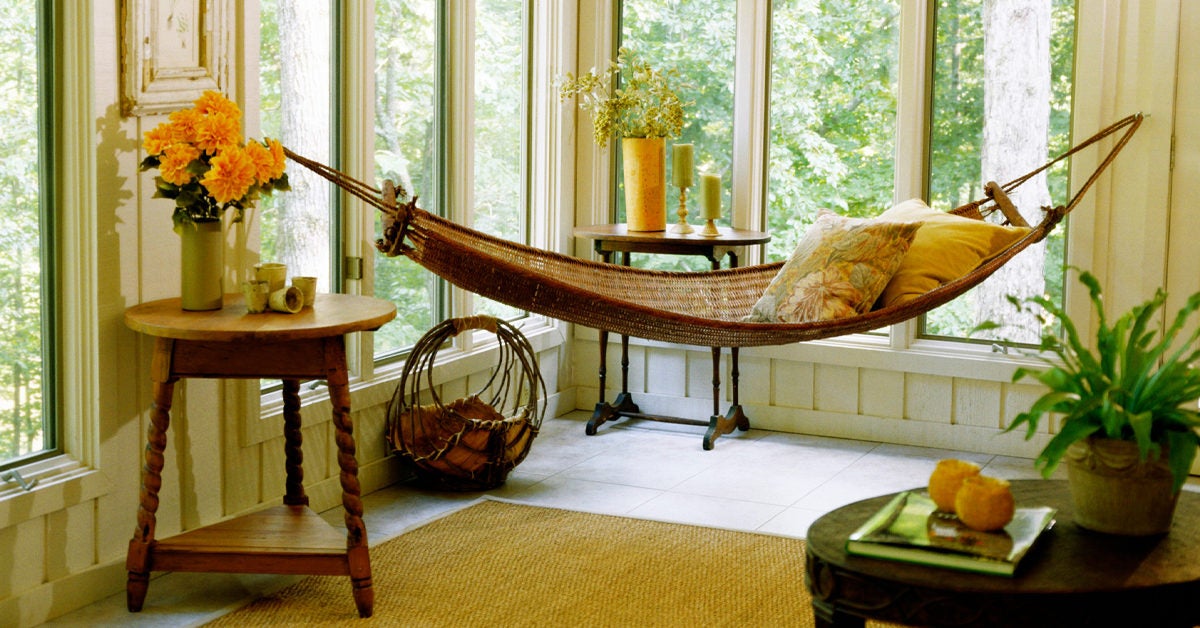Introduction
How To Hang A Hammock Indoors: Hanging a hammock indoors opens up a realm of possibilities, transforming your living space into a serene retreat where you can unwind, read a book, or simply daydream to your heart’s content. Whether you want to escape the daily hustle or embrace a new form of leisure, this comprehensive guide will take you through the essential steps of setting up a hammock indoors.

We will explore the various aspects of hanging a hammock inside your home, including choosing the perfect location, selecting the right hammock and suspension system, and ensuring a safe and secure setup. We’ll discuss different types of indoor hammocks, from freestanding hammock stands to ceiling-mounted solutions, to accommodate various living spaces and preferences.
Indoor hammocking offers a unique and versatile way to enhance your living environment, whether you have a spacious living room, a cozy bedroom, or even a sunny nook by the window. Embrace the freedom of personalization as you explore the art of indoor hammock hanging and create your oasis of tranquility within the four walls of your home.
How do you hang a hammock inside the house?
Screw in heavy-duty eye-bolts that are long enough to have at least 2 inches screwed into the solid wood joists. Attach chain, ropes, or cords to the end-loops of the hammock to get your desired length and sag. Hook these suspensions to the anchored hooks or eye-bolts with knots or carabiners.
Hanging a hammock inside the house requires careful consideration of the available space, the type of hammock, and the desired location. Here’s a step-by-step guide on how to hang a hammock indoors:
Choose the Location: Identify a suitable area in your home with enough space to accommodate the length of the hammock. Consider locations near windows, by a reading nook, or even in an open living room.
Select the Hammock Type: Decide on the type of hammock that suits your needs and the available space. You can choose from traditional fabric hammocks, hammock chairs, or compact hammocks designed for indoor use.
Find the Anchoring Points: Depending on the hammock type, you’ll need to find sturdy anchoring points. If using a freestanding hammock stand, ensure it can support the weight of the hammock and occupants. For ceiling-mounted setups, locate joists or sturdy beams.
Measure and Prepare: Measure the distance between the anchoring points to ensure the hammock will hang at a comfortable height. Prepare any necessary hardware, such as ceiling hooks or wall anchors.
Is it safe to hang a hammock chair indoors?
Your hammock swing chair or full body hammock can go in any bedroom, room, porch or balcony. Before you install your hammock indoors, make sure there is enough space for it to move freely.
Yes, it is generally safe to hang a hammock chair indoors if you take the necessary precautions and follow proper installation guidelines. Hammock chairs are designed for indoor use, and when installed correctly, they can provide a comfortable and relaxing seating option within your home.
Here are some important considerations to ensure the safety of hanging a hammock chair indoors:
Find Sturdy Anchoring Points: Look for strong and stable anchoring points in your ceiling or walls. Wooden ceiling joists or sturdy wall studs are ideal for securely attaching the hammock chair hardware.
Use High-Quality Hardware: Invest in high-quality hardware, such as ceiling hooks, eye bolts, or mounting kits designed specifically for hammock chairs. Avoid using regular screws or hooks that may not be strong enough to support the weight.
Check Weight Limits: Ensure that the hardware and the hammock chair can support the weight of the intended users. Always check the weight limits provided by the manufacturer to avoid overloading the chair.
Where not to hang a hammock?
Don’t hang your hammock near a bird’s nest or other habitat where wildlife may be resting or eating. Select a spot at least 200 feet from any water source to protect the delicate ecosystem where land meets water. Do not cut branches or deface a tree in order to get that “perfect spot.”
When hanging a hammock, there are certain locations and structures where it is not safe or recommended to do so. Avoiding these areas will help ensure your safety and prevent damage to property or harm to the environment. Here are some places where you should not hang a hammock:
Weak or Unstable Structures: Avoid hanging your hammock from weak or unstable structures, such as dead tree branches, rotten posts, or flimsy fences. These structures may not be able to support the weight and strain of the hammock, leading to potential accidents or damage.
Electrical Wires and Cables: Never hang a hammock near electrical wires, cables, or utility poles. Accidentally coming into contact with electrical lines can be extremely dangerous and potentially fatal.
Glass Windows or Fragile Objects: Hanging a hammock near glass windows or fragile objects is risky. A swinging hammock may collide with windows, mirrors, or delicate decorations, causing damage or injuries.
How much weight can an indoor hammock hold?
Hammocks can hold anywhere from 250 to around 800 pounds. And hammock chairs tend to hold 250 pounds. Hammock stands can usually hold a bit more weight than their hammock counterparts. For example, a hammock chair stand can hold 350 pounds, and a double hammock stand may be able to hold 500+ pounds.
The weight capacity of an indoor hammock can vary depending on the type, design, and material of the hammock. Most indoor hammocks are designed to support an average adult’s weight, which typically ranges from 250 to 400 pounds (113 to 181 kg). However, it’s crucial to check the manufacturer’s specifications and guidelines for the specific hammock you have, as weight capacities can differ significantly between different models.
Factors that affect the weight capacity of an indoor hammock include the quality and strength of the fabric or material used, the type of suspension system, and the hardware used for hanging. Some hammocks may have reinforced seams or double-stitched edges to increase their weight capacity and durability.
It’s essential to adhere to the specified weight limit to ensure the safety and longevity of the hammock. Exceeding the recommended weight capacity can lead to stress on the fabric and seams, compromising the structural integrity of the hammock and posing a safety risk.
If you plan to hang a hammock indoors, consider the combined weight of the individuals who will be using it. It’s always best to choose a hammock with a weight capacity that comfortably exceeds the combined weight of all users to ensure a safe and enjoyable experience.
What are the key considerations when choosing the location for hanging a hammock indoors?
When choosing the location for hanging a hammock indoors, several key considerations can ensure a safe, comfortable, and enjoyable experience:
Available Space: Measure the available space to ensure it can accommodate the length and width of the hammock, allowing for adequate swing and relaxation without obstruction.
Structural Support: Identify strong and sturdy anchoring points, such as ceiling joists or wall studs, capable of supporting the weight of the hammock and its occupants.
Ceiling Height: Consider the ceiling height in the chosen area. Ensure that the hammock’s suspension system allows for enough clearance from the floor to avoid touching the ground when occupied.
Safety and Clearance: Ensure there is ample space around the hammock to prevent collisions with furniture, walls, or objects, allowing for safe and comfortable entry and exit.
Weight Capacity: Confirm that the chosen location and suspension system can safely support the combined weight of the hammock and its occupants.
Child and Pet Safety: If there are children or pets in the household, ensure the hammock’s location is secure and out of their reach to prevent accidents.
Aesthetics: Choose a location that complements the overall interior design and enhances the visual appeal of the space.
By carefully considering these factors, you can select the ideal location for hanging an indoor hammock, creating a cozy and inviting retreat within your home for relaxation and peaceful moments of leisure.

What types of indoor hammocks are available, and how do they differ in terms of installation and usage?
There are several types of indoor hammocks available, each offering unique installation methods and usage experiences. Here are some common types of indoor hammocks and their differences:
Fabric Hammocks: Fabric hammocks are traditional hammocks made from various materials like cotton, polyester, or nylon. They typically feature spreader bars at each end, which keep the hammock open and flat when hung. Installation requires securing the hammock to two fixed anchor points, such as walls or ceiling hooks. Fabric hammocks are ideal for lounging, reading, or napping and provide a stable and comfortable surface.
Hammock Chairs: Hammock chairs, also known as hanging chairs or swing chairs, are suspended from a single point and provide a comfortable seat with back support. They often come with a spreader bar or are designed in a bucket-style shape. Hanging a hammock chair requires a single anchor point, and they are popular for creating cozy reading nooks or relaxation spots indoors.
Hammock Swings: Hammock swings combine the features of a hammock and a swing. They are wider than hammock chairs, offering more seating space, and are suspended from two anchor points. Hammock swings are versatile and suitable for both lounging and gently rocking back and forth.
Travel Hammocks: Travel hammocks are compact and lightweight hammocks designed for portability. They usually come with a suspension system, such as ropes or straps, making them easy to hang and take down. Travel hammocks are excellent for indoor use when you want the option to move them to different locations within your home.
Hammock Stands: While not a type of hammock itself, hammock stands are freestanding structures that support various hammock types. They are an excellent option when you want the flexibility to move the hammock indoors to different locations without the need for permanent anchors in the ceiling or walls.
The choice of indoor hammock will depend on your space, design preferences, and the desired usage. Each type offers its unique benefits, allowing you to create a cozy and inviting indoor oasis for relaxation and leisure activities.
What are the safety measures and hardware needed to hang a hammock indoors securely?
Ensuring the secure and safe hanging of a hammock indoors requires the use of appropriate hardware and following specific safety measures. Here are the key safety measures and hardware needed for a secure indoor hammock setup:
Ceiling Hooks or Eye Bolts: Use heavy-duty ceiling hooks or eye bolts made of strong materials, such as stainless steel, rated for the intended weight capacity. Install them into ceiling joists or wall studs for optimal stability.
Weight Capacity: Check the weight capacity of the ceiling hooks or eye bolts, as well as the hammock itself, to ensure they can support the combined weight of the hammock and its occupants.
Suspension Straps or Ropes: Utilize strong and durable suspension straps or ropes designed for hammocks. Avoid using regular ropes or chains, as they may not be suitable for prolonged hammock use.
Carabiners or S-Hooks: Use high-quality carabiners or S-hooks to attach the hammock to the suspension straps or ropes securely. Ensure they are rated for the hammock’s weight capacity.
Hammock Stand (Optional): If using a freestanding hammock stand, choose a sturdy and well-built stand that matches the hammock’s size and weight capacity. Ensure the stand is level on the floor to prevent tipping.
Clearance from Obstructions: Ensure that the hammock has enough clearance from walls, furniture, or other obstructions to prevent collisions and ensure a comfortable swinging motion.
How can one find and identify suitable anchoring points for hanging an indoor hammock?
Finding suitable anchoring points for hanging an indoor hammock involves identifying strong and sturdy structures in your home that can support the weight and stress of the hammock. Here’s how you can find and identify suitable anchoring points:
Locate Ceiling Joists or Wall Studs: Use a stud finder or gently tap on the ceiling to locate ceiling joists or wall studs. These are the strong, vertical beams behind the drywall or plaster that provide stable support for the hammock. Ceiling joists and wall studs are typically spaced at regular intervals, usually 16 to 24 inches apart.
Use a Stud Finder: A stud finder is a handheld device that detects changes in density behind the wall or ceiling. It can help you accurately locate the position of the ceiling joists or wall studs.
Inspect for Load-Bearing Walls: Load-bearing walls are walls that support the weight of the structure above them. Hanging the hammock from a load-bearing wall provides additional structural stability.
Measure the Space: Once you’ve identified potential anchoring points, measure the distance between them to ensure it aligns with the length of your hammock. Make sure the hammock hangs level and with enough clearance from the floor.
Consult a Professional: If you’re unsure about the structural integrity or load-bearing capacity of the ceiling or walls, consult a professional handyman or contractor. They can provide expert advice and help reinforce the anchoring points if needed.
Use Freestanding Hammock Stands (Optional): If you don’t have suitable ceiling joists or wall studs, consider using a freestanding hammock stand. These stands provide a stable base for indoor hammocks and don’t require permanent anchoring.
By identifying suitable anchoring points, you can ensure a safe and secure indoor hammock setup, allowing you to relax and enjoy the comfort of your hammock without worrying about structural integrity. Always prioritize safety and take the time to find the most reliable anchoring points for your indoor hammocking experience.

Conclusion
Choosing the perfect location is essential, ensuring ample space, structural support, and a suitable ambiance for your indoor hammock haven. Identifying strong anchoring points, such as ceiling joists or wall studs, is crucial for a secure and stable setup. Additionally, using high-quality hardware, suspension straps, and carabiners ensures the hammock can safely support its intended weight capacity.
Indoor hammocking offers a versatile and inviting space for relaxation, reading, or daydreaming, creating a cozy retreat for both individuals and families to unwind and recharge. It brings the joy and tranquility of outdoor hammocking into the comfort of your own home, allowing you to escape the stresses of the outside world whenever you desire.
Remember to regularly inspect the hammock setup for any signs of wear or damage, and adhere to the weight capacity guidelines provided by the manufacturer. With proper care and attention to safety measures, your indoor hammock setup will provide countless moments of relaxation and bliss.
Embrace the art of indoor hammock hanging, and let the gentle sway of the hammock carry you away to a realm of comfort and serenity. Whether you hang your hammock near a window, in a cozy nook, or in a spacious living room, may your indoor hammock become a cherished sanctuary where you can unwind, dream, and create lasting memories with loved ones.


